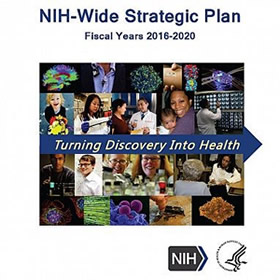
Dear Colleagues:
NIAMS supports research, trains basic and clinical scientists and disseminates information to improve the Nation’s health and reduce illness and disability. Last summer, I highlighted tools for learning about the tax-payer funded projects that we support. As noted below, NIH also has many resources for investigators while planning their work, applying for funding, conducting studies and sharing results.
Learning about NIH scientific priorities
Each of the 27 Institutes and Centers has a distinct mission. Most have a long-range or strategic plan and also contribute to NIH-wide and interagency plans on areas of shared interest. Developed with input from hundreds of stakeholders and scientific advisors, the NIH-Wide Strategic Plan (Fiscal Years 2016-2020) complements these plans. Visit the NIAMS Long-Range Plan (Fiscal Years 2015-2019) for a broad outline of scientific opportunities and needs to understand, diagnose, treat and prevent bone, joint, muscle and skin diseases, as well as efforts to ensure that a diverse and highly skilled workforce is available to conduct biomedical and behavioral research.

The vast majority of NIAMS-funded grants are "investigator-initiated," meaning the researcher selects the scientific question and the approach for answering it. These projects represent the best, most promising ideas from scientists at universities, academic medical centers, and research institutions across the country. However, understudied areas may get some targeted attention in the form of topic-specific program announcements or requests for applications. I encourage all investigators to subscribe to the NIH Guide to Grants and Contracts—the official publication for grant policies, guidelines and funding opportunities—to learn about initiatives from NIAMS and other Institutes and Centers.
Applying for funding

The NIH Office of Extramural Research maintains a robust website that walks prospective applicants through the grants process. The site explains a researcher’s and grantee institution’s responsibilities after NIH funds an award. The website also provides an orientation to the NIH, help with planning and writing applications and a description of peer review. The NIH Center for Scientific Review has additional videos explaining the peer review process.
Working on a team
Increasingly, biomedical research involves teams that vary in size, disciplines and structure. In 2006, NIH began allowing more than one Principal Investigator to lead individual awards.

To help scientists manage, support and conduct team-based research, the National Cancer Institute hosts a website called the Team Science Toolkit. One of its many resources is a straightforward series of pages that spell out questions investigators should answer before agreeing to collaborate, approaches for evaluating team members’ contributions and strategies for resolving conflict.
Mining data
NIH invests in a variety of projects that collect data any researcher can access when developing and testing hypotheses. For example, patient registries provide anonymized data that investigators can use to understand a disease course and identify factors that may influence patient outcomes. Scientists in our mission areas may be particularly interested in the alopecia areata, arthritis, lupus and muscular dystrophy registries across the country.

Many NIH-funded activities generate rich sets of biochemical and biological data that are accessible to the broad biomedical community for additional studies. Some, such as the Accelerating Medicines Partnership and the Molecular Transducers of Physical Activity Consortium, are in their earliest stages. Other established projects are being used widely. For example, data and images from the Osteoarthritis Initiative have led to over 300 peer-reviewed publications. More than 4,100 researchers from over 90 countries have accessed this database.
For studies toward the molecular end of the research continuum, the National Library of Medicine’s National Center for Biotechnology Information (NCBI) develops and maintains databases for exploring fundamental processes that influence health and disease.
Sharing your results
Consistent with our obligation to ensure that the public has access to federally funded research results, the NIH Public Access Policy sets out certain grantee requirements. Researchers must ensure that their journal manuscripts based on NIH-supported work are available through the PubMed Central digital archive. Additional policies also apply to some projects. For example, scientists who are generating or using large-scale genomic data should refer to the NIH Genomic Data Sharing policy, while clinical researchers should look through the NIH Policy on the Dissemination of NIH-Funded Clinical Trial Information.

Remember that referencing federal funding—in scientific publications and presentations, press releases, videos, interviews and other communications—is essential for raising awareness about the important role NIH plays in improving our Nation’s health. While a future letter will explore this in more detail, please know that the NIAMS Office of Science Policy, Planning and Communications (OSPPC) is always happy to work with you and your press office to ensure that you have the appropriate language to include when sharing your findings with colleagues and the public.
Stephen I. Katz, M.D., Ph.D.
Director
National Institute of Arthritis and Musculoskeletal and Skin Diseases
National Institutes of Health
